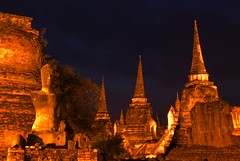
Wat Si Sanphet
The diminutive Thai security guard approached me out of the gathering gloom of dusk, the spotlight casting his giant shadow against the illuminated chedi. We close now he politely said, beckoning me towards the exit. It was sadly time to drag myself away from the magical temple courtyard of Buddha statues, broken columns, white-flowering trees, bell-shaped chedis and towering prangs all brightly lit in yellows, oranges and greens. I had just taken my last photograph of the row of three graceful chedis of Phra Si Sanphet, each topped with spires of ever-diminishing discs, that glowed against the now-black sky. The tour parties had long departed; leaving me to watch the sunset paint the sky red behind the technicolour temples in tranquil solitude. I reluctantly headed for the exit, taking one last glance over my shoulder at the multicoloured wonderland before cycling back to my hotel through the historical parkland.
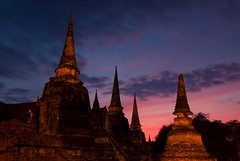
Wat Si Sanphet Sunset
Ayutthaya was founded 700 years ago on an island formed by the confluence of three fast-flowing rivers as the second great royal capital of Siam. Completely encircled by the rivers and criss-crossed with canals, it was aptly dubbed the Venice of the East by the first European explorers to set their eyes on the city in the 1500s. The city was a metropolis capital, religious centre and trading port. Ships regularly visited its riverside wharves from Europe, Indonesia, Malaysia, Japan, India, Persia, Arabia and China while Siamese ships sailed in the opposite directions across the Indian Ocean and South China Sea. The great Chinese naval captain Zheng visited Ayutthaya in 1407 and made a benefaction to the nearest temple to the portside warehouses. Foreign trading communities lived in specially designated residential quarters where they were allowed to govern themselves and follow their own religions. Ayutthaya flourished for 400 years until sacked by the Burmese army in 1767.
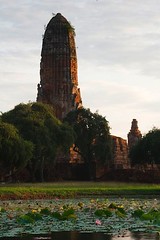
Wat Phra Ram with lotus flowers
The Buddhist Kings of Siam built monumentally beautiful temples, known as wats, to honour their departed fathers. The Burmese destroyed much, decapitating most of the Buddha statues, but the main temple structures survived the flames and hammers. Most of the temples and palaces that remain today are preserved in an historical park of fragrant trees, lotus-filled canals and white-painted bridges that occupies much of the western half of the island. Modern Ayutthaya takes up the remaining half, its streets following the same grid pattern followed by the canals. The city lies on the flat floodplain about an hour and a half drive north of Bangkok.
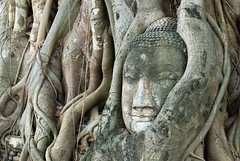
Buddha head at Wat Matathat
The very centre of the Siamese Kingdom was found under the prang of Wat Matathat, a type of temple that lay at the heart of every major Siamese city and under which lay buried a relic of Buddha. Following archaeological excavations in 1956, the relic has been on display in one of the city museums. Matathat is notable for a fallen Buddha head that has been taken up by the twisted roots of a banyan, a Buddhist holy tree. This growing together of nature and art is seen as very auspicious by Thais and it is sometimes decorated with cloth and offerings to request merit from the Buddha.

Nagas and Garuda of Wat Rathchaburana
Next door to Matathat is Wat Ratchaburana which has the best surviving prang in Ayutthaya rising above the trees. Each temple is laid out as a square and aligned on the compass points. The prang is in the very centre and represents Mount Meru, the holy mountain of the Buddhist heaven. Chedis surround the prang, each representing a cosmic plane. Chedis at the four corners stand for the four human universes of physical being. Ratchaburana’s prang still preserves the stucco relief statues of garudas, nagas and other mythical beasts. Robbers unfortunately dug below the prang and made off with a treasure of royal gold but thankfully two of them were caught and some of the gold objects saved.

Wat Phra Ram sunrise
Across the park, the prang of Wat Phra Ram is reflected in the surrounding canals, and best seen at sunrise or sunset. Next to it is Wat Phra Si Sanphet with its line of three chedis. This was the temple of the Siamese royal family and the adjacent remains of the extensive palace lie in manicured lawns.
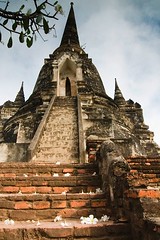
Flowers for a King
These four wats comprise the core of ancient Ayutthaya and are easily visited on foot or by bicycle through the historical park. They all become magical lanterns towering into the night sky when the spotlights are turned on at sunset.
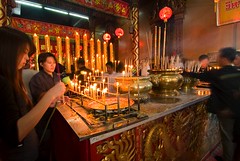
Wat Phanan Choeng
Other ruined chedis and walls pop up on the roadside throughout the modern city. Further away and off the island are three major riverside temples. Wat Phanan Choeng, the temple associated with Zheng He, is to the east of the island. Very much an active working temple, it is bustling with devotees praying in the halls decorated with Chinese script and dragons.

Wat Yai Buddhas doing here?
It is a short distance to the delightful garden temple of Wat Yai Chai Mongkhon, which is again busy with devotees. Hundreds of Buddha status, each draped on orange sashes, line the four walls of the central courtyard and gaze down impassively in front of the central chedi. Climb up into the chedi and you find seven Buddhas covered in gold leaf and set in niches. Thais come to speak merit requests into small pieces of paper, wipe them on the Buddhas then cast them in to baskets. Gardens of flowering trees and shrubs extend outside the courtyard and make a suitable environment for a giant sculpture of a reclining Buddha to enjoy dappled shade.
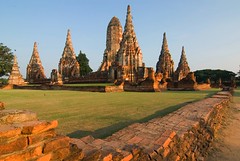
Wat Chai Wattanaram
To the west of the island is Wat Chai Wattanaram, which has more chedis surviving around the central prang than any other temple. Visit in the late afternoon to enjoy the breathtaking sunset then stay to watch it also come alight after dark. Two rarely-visited temples to the west of the island contain an ornate Ayutthaya-style Buddha-as-King statue and the only Burmese temple architecture in the city. These off-island temples can be visited by the more adventurous on bicycle, and Thai drivers tend to be relatively considerate, or by Sawngthaew, the small three-wheeled open-sided taxis that buzz around the roads.
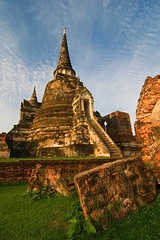
One Chedi of three at Wat Si Sanphet
You can visit all the temples independently, which are open from 7.30am to 6.30pm for an entry fee of 20 to 30 baht at each, or join one of the many tours that take you around all of the main wats in one day or the five illuminated wats at night. Most people spend one hot day or an overnight afternoon/morning visiting the temples. But, if you have more time, slow down to take in only two or three temples a day, wander through the historical park and make sure you visit the Historical Study Centre and the Museum to see the gold objects and Buddha relic excavated from below the prangs of Wats Matathat and Ratchaburana.
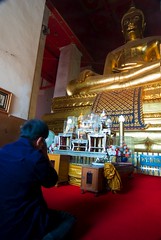
Golden Buddha
The temples are best seen in early morning and late afternoon when the wats take on an orange hue and their architecture is picked out by the shadows of the low sun. Make sure you stay later at Chai Wattarama or Si Sanphet to savour the vibrant colours when sunset mixes with the illuminated wats. That is the time when the colourful magic visits and you won’t want to return to the black and white world outside.
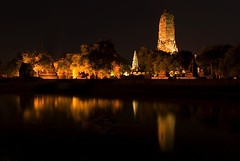
Reflections on a Wat



October 2009 update
ReplyDeleteTicket prices for each major central wat have now gone up to 50B each.